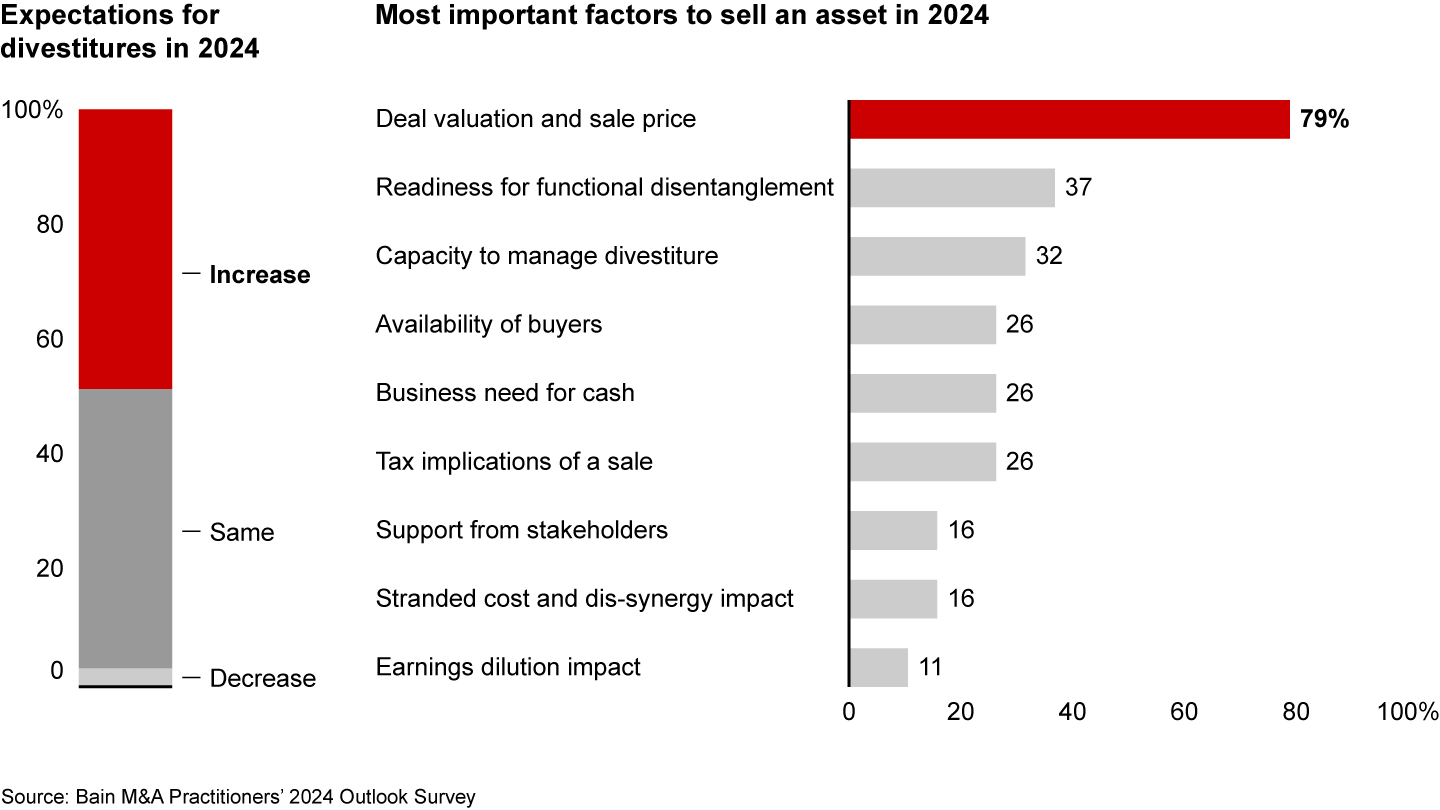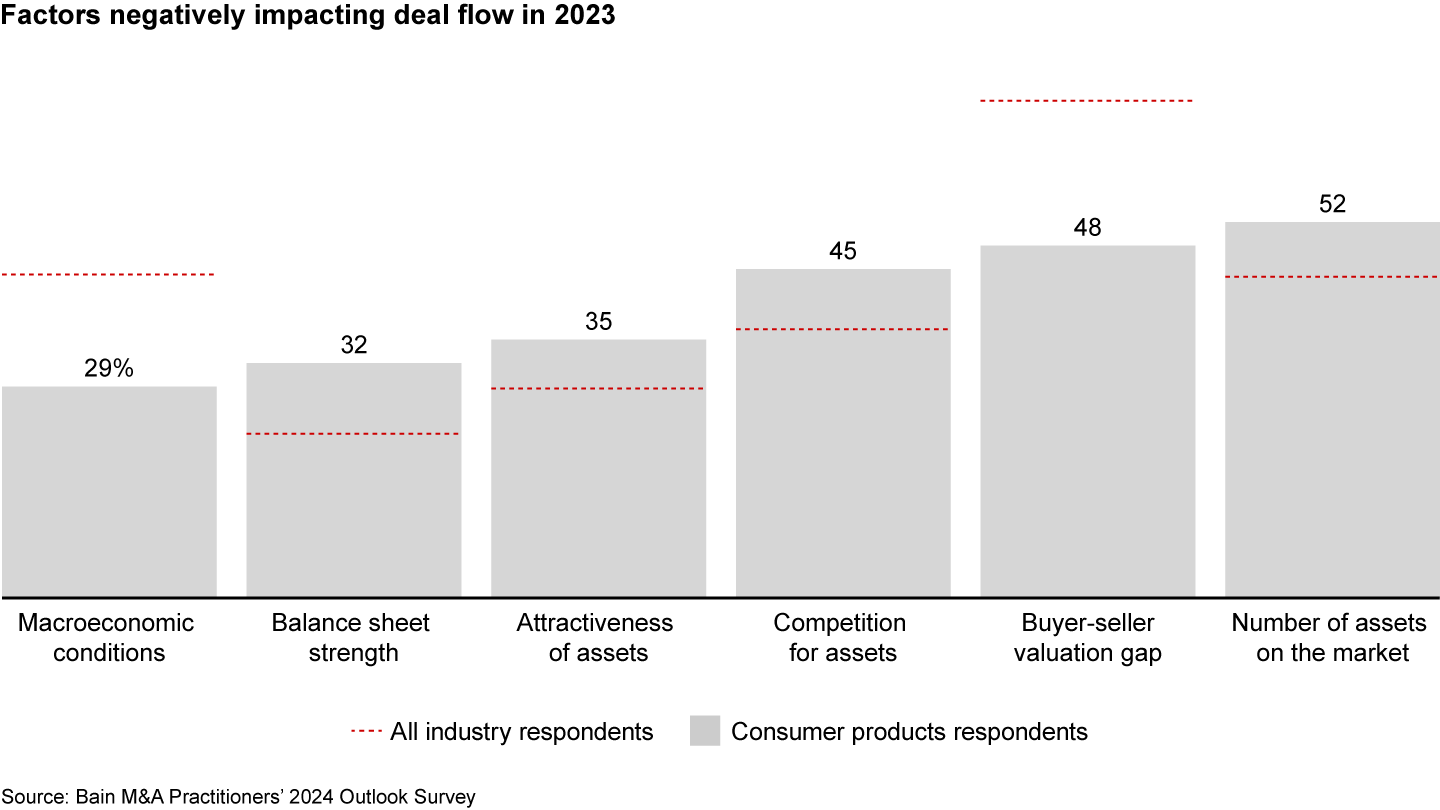M&A Report
 }
}
At a Glance
- Consumer products companies have been doing fewer deals, and those they have done look beyond traditional competitors.
- While M&A remains critical to strategy, large-scale combinations are increasingly too broad, risky, and time consuming.
- Smaller deals could be the answer, but they are becoming more difficult to find and close given the current economic, regulatory, and geopolitical uncertainty.
- To be successful, consumer products companies have to rethink their M&A capabilities to be more creative, more flexible, and faster.
This article is part of Bain's 2024 M&A Report.
The year 2023 saw the number of deals in consumer products sink to the lowest level in more than 10 years, while total deal value rose by an estimated 26%, largely boosted by Johnson & Johnson’s Kenvue spin-off (see Figure 1). But in the years ahead, we expect fewer such megadeals in consumer products as the industry shifts away from the typical scale deals between close competitors that generate cost synergies to invest back into growth. Instead, we will see an escalation of the current trend in which companies are willing to look more broadly and buy smaller businesses before private equity or venture capital buyers get there first.

Much of the industry’s recent sales growth has been the result of price inflation. As inflation eases, companies are under pressure to return to a profitable volume-led growth model. Also, margins have been squeezed by shifts across the value chain, and many companies have struggled to deliver for shareholders. All of this is happening while structural rules are challenged: Companies need to invest in digitization, they need to address the impact of generative AI, and they need to consider their prospects in markets such as Russia and China, for example.
Against this backdrop, consumer products companies are plotting ways to align their portfolios against growing profitable segments and to ensure that they offer the right goods and services to meet increasingly fragmented consumer needs. They’re figuring out how to simplify the portfolio to allow for greater profitability. For many, this level of change can’t be achieved organically. They need to acquire assets to reinforce focus segments. And they need disciplined divestments, with roughly 50% of consumer products M&A practitioners telling us that they expect more divestitures in the industry in 2024 if the right buyers can be found (see Figure 2).

While M&A remains critical for profitable growth, large deals with traditional competitors have become more expensive, protracted, and risky. Many product categories have become concentrated among the leading players, with most new innovation and growth at the smaller end of the spectrum. For example, in beer and lager, the top 10 firms now make up about 65% of the market (up from about 55% in 2009). Nonalcoholic hot beverages, personal care, household care, and consumer health follow similar patterns of increasing concentration. The bottom line is that any scale moves by those companies are likely to come under scrutiny in a regulatory environment that has become more proactive, fulsome, and time consuming. Witness the delay and further review by the US Federal Trade Commission of Campbell’s pending acquisition of insurgent Sovos Brands.
Also, larger deals are increasingly viewed as blunt tools when consumer products companies need something sharper to pursue targeted opportunities in specific growth vectors—everything from food service to home delivery to products aligned with health and wellness, convenience, and sustainability. So, the hunt for attractive smaller deals is on. But while they may minimize the risk of any one large deal, it takes patience and discipline to create value across a portfolio of acquisitions. Indeed, smaller deals come with a series of opportunities and caveats.
Opportunity: Insurgent brands can offer exciting growth, alignment with consumer trends, and attractive purpose-led strategies.
Caveat: Acquisition success has been mixed. While winners have gotten better at not damaging the assets through overintegration, the jury is still out on how best to scale capabilities across the insurgent and core portfolio.
Opportunity: Orphan underinvested businesses or brands hiding within the portfolios of larger consumer products companies can offer attractive divestiture opportunities, such as the spin-offs of Upfield and Lipton by Unilever.
Caveat: Managing the carve-out can be challenging enough while also juggling the reintegration with another business.
Opportunity: With Russia out of scope, and dealmakers wary of commitments in China, many companies see opportunities to acquire in India and Southeast Asia for a structural growth boost. Consider Hormel Foods’ minority investment in Garudafood.
Caveat: The consumer needs and business environment in these attractive markets can be very different from potential investors’ home markets.
Having identified the right deals, they then need closing. Despite high interest rates, the biggest barrier to dealmaking in 2023 cited by M&A practitioners in consumer products wasn’t the cost of debt; it was the scarcity of attractive assets on the market, followed by the buyer-seller valuation gap and increased competition for assets (see Figure 3).

This is not a surprise. For acquirers, deals look expensive given the current shaky global economic outlook. Meanwhile, sellers still believe in their businesses. Indeed, deal multiples held relatively constant since the first quarter of 2022 through September 2023. The result has been much scanning, some diligence, but relatively little dealmaking. Deals that have gone ahead have attracted high premiums. For example, J.M. Smucker bought Hostess Brands at about a 50% premium to the closing share price prior to press coverage.
Those same M&A practitioners in consumer products do not see this changing anytime soon, with roughly 35% expecting fewer deals next year and another 32% seeing the same number.
Winning in this environment requires a rethink of the M&A process and capabilities to be more creative, more flexible, and faster.
Companies need to refocus their M&A on the basics of creating profitable volume growth across their portfolio. This can be through deals that are grounded in increasingly complex consumer needs (across market, channel, and category) while also being clear on the unique parenting advantages they bring to an asset—advantages such as local relative market share or scaling of the value chain. Equally important is pruning their business of brands that don’t meet these criteria but might for another company.
With this in mind, we see opportunity to modify the key elements of the M&A value chain to better suit these goals.
Screening must be more proactive and holistic, reaching beyond the known large or midsize competitors. The most successful will update the screen to include new strategic criteria such as the environmental, social, and corporate governance (ESG) impact; channel relevance; and digital capabilities. They’ll search not only for standalone options but also for those hidden within others’ portfolios.
For the highest-priority targets, a deal thesis must be created earlier—and not just for diligence. Leadership needs education, relationships need to be made, and speed is of the essence to compete with other consumer products companies and financial investors.
Once the right target list is in place, acquirers must bring greater creativity to diligence to justify the deal premium. It should focus on the issues that really matter but that are often unclear—for instance, real lasting consumer relevance, the longer-term ESG impact, and the upsides that the parent can bring to growth and profitability. It should think through how the brand or company will be integrated to enable the cost or revenue upside.
Integration of smaller assets must be more thoughtful. We have seen many fail because of overintegration, particularly in the early stages (for more, see “A Wave of Scope Deals and Portfolio Changes in Consumer Products”). Underintegration, however, can also stifle the generation of synergies. Buyers need to start with a clear articulation of what value needs to be created, leading to which areas of the business need to be integrated (and which don’t).
Finally, when it comes to mastering a portfolio of smaller deals, doing a deal once is not enough. Successful acquirers continually evolve their operating model and codify learnings from every deal into clear playbooks.


